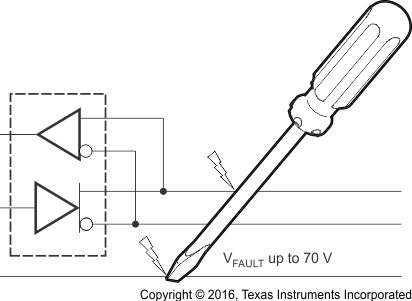SLLSE49E September 2010 – October 2024 SN65HVD1780-Q1 , SN65HVD1781-Q1 , SN65HVD1782-Q1
PRODUCTION DATA
- 1
- 1 Features
- 2 Applications
- 3 Description
- 4 Pin Configuration and Functions
- 5 Specifications
- 6 Parameter Measurement Information
- 7 Detailed Description
- 8 Application and Implementation
- 9 Device and Documentation Support
- 10Revision History
- 11Mechanical, Packaging, and Orderable Information
Package Options
Mechanical Data (Package|Pins)
- D|8
Thermal pad, mechanical data (Package|Pins)
Orderable Information
3 Description
These devices are designed to survive overvoltage faults such as direct shorts to power supplies, mis-wiring faults, connector failures, cable crushes, and tool mis-applications. They are also robust to ESD events, with high levels of protection to the human-body-model specification.
These devices combine a differential driver and a differential receiver, which operate from a single power supply. In the 'HVD1782, the driver differential outputs and the receiver differential inputs are connected internally to form a bus port suitable for half-duplex (two-wire bus) communication. This port features a wide common-mode voltage range, making the devices suitable for multipoint applications over long cable runs. These devices are characterized from –40°C to 125°C. These devices are pin-compatible with the industry-standard SN75176 transceiver, making them drop-in upgrades in most systems.
These devices are fully compliant with ANSI TIA/EIA 485A with a 5V supply and can operate with a 3.3V supply with reduced driver output voltage for low-power applications. For applications where operation is required over an extended common-mode voltage range, see the SN65HVD1785 (SLLS872) data sheet.
| PART NUMBER | SIGNALING RATE(1) | NUMBER OF NODES |
|---|---|---|
| SN65HVD1780-Q1 | Up to 115kbps | Up to 320 |
| SN65HVD1781-Q1 | Up to 1Mbps | Up to 320 |
| SN65HVD1782-Q1 | Up to 10Mbps | Up to 64 |
 Simplified Schematic
Simplified Schematic